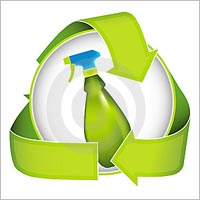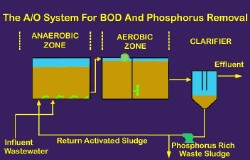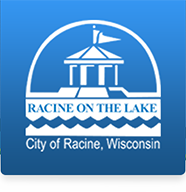-
-
City of Racine WasteWater Utility

Nate Tillis
Wastewater Utility Director

Mary Frances Klimek
Plant SuperintendantContact Info:
City Hall Annex Room 227
800 Center Street
Racine, WI 53403Phone: 262-636-9181
Fax: 262-636-3933
Bills and InvoicesBasement Backup
24 hour emergency numberPhone: 262-636-9520
Phosphorus and Nitrogen
-
Phosphorus and Nitrogen
ECO-FRIENDLY DETERGENTS & SOAPS
 After the soapy water goes down the drain, it goes to a wastewater treatment plant. Because detergents and soaps use phosphates as a cleanser, the water needs to be treated to remove as much of the phosphorus as possible.
After the soapy water goes down the drain, it goes to a wastewater treatment plant. Because detergents and soaps use phosphates as a cleanser, the water needs to be treated to remove as much of the phosphorus as possible.At the wastewater treatment plant, the soapy water is treated and then discharged into Lake Michigan. Some treatment methods are more successful at removing phosphates than others, so not all of the phosphates are removed.
One easy way to avoid costly treatment processes is to cut down on the use of phosphorus soaps and detergents at home. If the phosphorus from your soap and detergent does not go down the drain, the treatment system will not have to remove it.
Below are some suggestions for minimizing the amount of phosphorus you send down the drain.
What you can do:
- Choose phosphate-free detergents, soaps, and household cleaners
- Select the proper load size for your washing machine
- Only run your clothes or dishwasher when you have a full load
- Use the appropriate amount of detergent; more is not better
- Select Energy Star appliances that use less energy and less water
Learn more about the effect of detergents and soaps on your environment. Become an informed and environmentally friendly consumer.
DRIVING GREEN
 When we drive, we burn fossil fuels and create nitrogen oxides that exit our automobiles’ tailpipes and end up in the atmosphere. These nitrogen-containing compounds later fall to earth, depositing on both land and water. Land-deposited nitrogen oxides can enter storm water systems when it rains and thus further pollute our waters.
When we drive, we burn fossil fuels and create nitrogen oxides that exit our automobiles’ tailpipes and end up in the atmosphere. These nitrogen-containing compounds later fall to earth, depositing on both land and water. Land-deposited nitrogen oxides can enter storm water systems when it rains and thus further pollute our waters.Cities and communities across the nation are taking steps to reduce the amount we drive. Smart urban planning, such as mixed, dense commercial and residential communities, reduces sprawl by giving residents a place to work, shop, and have fun right in their own backyards.
Many metropolitan areas offer a blend of transportation alternatives, complemented by numerous Web- and print-based services that help travelers navigate a city’s public transportation system or help carpoolers link up with other commuters interested in protecting the environment or saving money by reducing their use of fuel.
Our transportation systems are also being designed more innovatively, such as use of “hot lanes” in some areas so travelers can pay to avoid traffic and thus waste less fuel, or providing commuters with live traffic updates so that they can better plan their routes to avoid congested roads.
What you can do:
- Be smart about how and when you drive; driving less is both good for the environment and easy on the wallet
- Carpool
- Take public transportation
- Consider alternative means of travel, such as biking or walking whenever practical
- Telecommute from home
- Opt for flex fuel, diesel, hybrid, compact, or other fuel efficient vehicles
Get better gas mileage:
- Routinely check tire pressure
- Avoid using the air conditioning during city driving
- Be light on the gas by using smooth acceleration/deceleration and maintain a constant speed
- Regularly service and perform maintenance on your car
- Avoid driving with extra weight in the car; transport only necessary items
GREEN ELECTRICITY
 Every time you turn on a light switch, television, radio, or microwave, electricity is sent from a power plant to your house. In most cases, to create the energy needed to turn on that light bulb, fossil fuels are burned, releasing harmful gases and particulates into the air. The gases and particulates fall out of the air and most of them end up in our water bodies, negatively impacting aquatic species. Although more environmentally friendly methods of electricity generation are being developed and slowly implemented, decreasing the demand for energy is the best way to reduce emissions from power plants. Below are some suggestions of what you can do at home.
Every time you turn on a light switch, television, radio, or microwave, electricity is sent from a power plant to your house. In most cases, to create the energy needed to turn on that light bulb, fossil fuels are burned, releasing harmful gases and particulates into the air. The gases and particulates fall out of the air and most of them end up in our water bodies, negatively impacting aquatic species. Although more environmentally friendly methods of electricity generation are being developed and slowly implemented, decreasing the demand for energy is the best way to reduce emissions from power plants. Below are some suggestions of what you can do at home.What you can do:
- Turn off the lights when leaving a room
- Purchase a programmable thermostat to automatically adjust temperatures throughout the day or when you are not at home
- Adjust the thermostat by a few degrees to be slightly warmer in the summer and cooler in the winter
- Set the temperature before leaving the house so the house is warmer (summer) or cooler (winter) to use less electricity while you are gone
- Replace old light bulbs with new energy efficient bulbs
- Use a power strip to turn on and off electronic devices
- Unplug your cell phone charger or other infrequently used electronics when not in use
- Open shades to utilize daylight instead of turning on lights; on cool days this helps to keep rooms warmer
- In the summer, close shades when not in the room to keep rooms cooler and use less electricity
- Activate power management features on your computer
- Hang-dry clothes instead of using the dryer
- Install solar panels
- Find out if it is possible to switch to wind generated energy
BE GREEN WHEN YOU WASH THE MACHINE
 When washing your car at home, do you ever wonder where the dirt, grime, and soap goes after it washes down your driveway? It likely goes down a storm drain, where it will be sent untreated to a local stream or river. Some states are beginning to address this issue by developing ordinances to regulate what goes down the drain with the storm water. Below are some suggestions of what you can do.
When washing your car at home, do you ever wonder where the dirt, grime, and soap goes after it washes down your driveway? It likely goes down a storm drain, where it will be sent untreated to a local stream or river. Some states are beginning to address this issue by developing ordinances to regulate what goes down the drain with the storm water. Below are some suggestions of what you can do.- Use a commercial car wash; commercial car washes are required to properly dispose of wastewater and many filter and recycle their water
- If washing your car at home consider the following actions:
- Wash your car on a pervious surface such as grass or gravel (not concrete or asphalt) so water is filtered before reaching a water body
- Use nontoxic, phosphate-free soaps
- Use soap sparingly
- Minimize runoff by reducing water use, using a spray nozzle to restrict water flow
- Wring out sponges and rags over the bucket or in a sink, not the ground
- Empty wash water into the sink or toilet (or the grass if you wish to dispose of it outside)
- Use waterless car wash products for spot-cleaning or a car wash kit, which redirects water from storm drains
- When conducting car wash fundraisers use a car wash kit; many cities will lend kits free of charge to groups conducting car washes for fundraising, or you can buy car wash kits
- Become an informed and environmentally friendly consumer.
WE’RE IN THIS TOGETHER

AS AN INDIVIDUALDid you know there are a number of actions you can take as an individual to help prevent excessive nitrogen and phosphorus pollution into your local watershed? Your actions can make a difference! Decisions you make about your garden can impact the water quality of nearby rivers and streams. Use fertilizers sparingly and sweep up driveways, sidewalks and gutters. Plant ground cover in bare spots in your yard. Never dump anything down storm drains or in streams. Take your car to the car wash instead of washing it in the driveway. Pick up after your pet.
AS PART OF A COMMUNITY
Your local watershed can provide an opportunity for community involvement. Watersheds are those land areas that catch rain or snow and drain to specific marshes, streams, rivers, lakes, or to ground water.
NUTRIENT’S GLOSSARY
 Some definitions specific to the nutrients are listed below:
Some definitions specific to the nutrients are listed below:Algal bloom
Sudden spurts of algal growth, which can affect water quality adversely and indicate potentially hazardous changes in local water chemistry.Chlorophyll
A green photosynthetic pigment found in most plants, algae and cyanobacteria.Eutrophication
The slow aging process during which a lake, estuary, or bay evolves into a bog or marsh and eventually disappears. During the later stages of eutrophication the water body is choked by abundant plant life due to higher levels of nutritive compounds such as nitrogen and phosphorus. Human activities can accelerate the process.Hypoxia/Hypoxic Waters
Waters with dissolved oxygen concentrations of less than 2 ppm, the level generally accepted as the minimum required for most marine life to survive and reproduce.Microbe
Microorganisms such as bacteria, algae, diatoms, plankton, and fungi.Nitrate
A compound containing nitrogen that can exist in the atmosphere or as a dissolved gas in water and which can have harmful effects on humans and animals. Nitrates in water can cause severe illness in infants and domestic animals. A plant nutrient and inorganic fertilizer, nitrate is found in septic systems, animal feed lots, agricultural fertilizers, manure, industrial waste waters, sanitary landfills, and garbage dumps.Nutrient
Any substance assimilated by living things that promotes growth. The term is generally applied to nitrogen and phosphorus in wastewater, but is also applied to other essential and trace elements.Phosphorus
An essential chemical food element that can contribute to the eutrophication of lakes and other water bodies. Increased phosphorus levels result from discharge of phosphorus-containing materials into surface waters.Phytoplankton
That portion of the plankton community comprised of tiny plants; e.g. algae, diatoms.Wastewater
The spent or used water from a home, community, farm, or industry that contains dissolved or suspended matter. Water Pollution is the presence in water of enough harmful or objectionable material to damage the water’s quality.Sewage
The waste and wastewater produced by residential and commercial sources and discharged into sewers.WHAT’S THE PROBLEM?
 Eutrophication, the prolific growth of algae in summer months.
Eutrophication, the prolific growth of algae in summer months.Like the human body, water bodies require nutrients, such as nitrogen and phosphorus, to be healthy, but too many nutrients can be harmful. Many of our nation’s waters, including streams, rivers, wetlands, estuaries, and coastal waters, are affected by nitrogen and phosphorus pollution. The effect of nitrogen and phosphorus pollution for a given water body depends on its ecoregion and its sources of nitrogen and phosphorus.
High levels of nitrogen and phosphorus in waters can produce harmful algal blooms. In turn, these blooms can produce “dead zones” in water bodies where dissolved oxygen levels are so low that most aquatic life cannot survive. This condition in water bodies is referred to as hypoxia.
Here are some things that contribute to nitrogen and phosphorus pollution:
- Overusing fertilizer (both residential and agricultural usage)
- Rainfall flowing over cropland, animal feeding operations and pastures, picking up animal waste and depositing it in water bodies
- Rainfall flowing over urban and suburban areas where storm water management is not required (e.g., parking lots, lawns, rooftops, roads)
- Discharge of nitrogen and phosphorus from waste-water treatment plants
- Overflow from septic systems



